Answering the When, How, and Where of the Kenya Wildebeest Migration
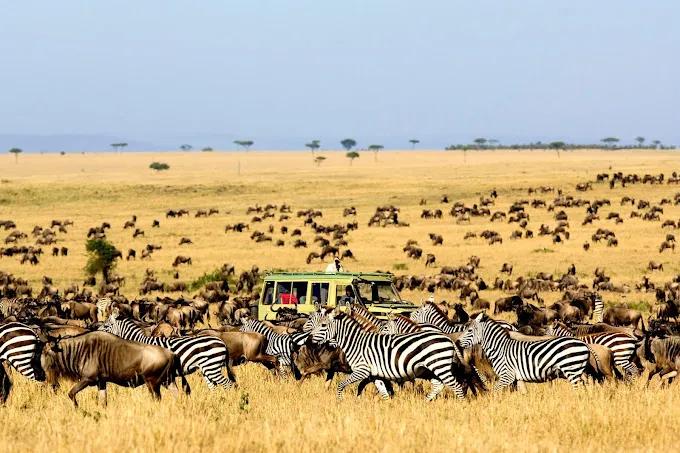
The Kenya Wildebeest Migration is a pivotal ecological event that spans over 1,800 miles across the Serengeti-Masai Mara ecosystem. It involves over 2 million wildebeest, zebras, and gazelles and is triggered by the seasonal rains and the wildlife’s search for greener pastures.
Pinpointing the exact time it happens can be tricky, but our guide demystifies the migration calendar and offers practical advice to ensure you witness these extraordinary moments, whether it’s the dramatic river crossings or the spectacle of peak season herds.
But First…
Here’s Where to Reach Us to Start Planning Your Migration Safari
Call or WhatsApp us at +254-704-532-105 or send us an email at safarioffers@kenyasafariholidays.uk, safarioffers@ajkenyasafaris.com, or james@ajkenyasafaris.com
And Here are Some of our Most Booked Masai Mara Safaris
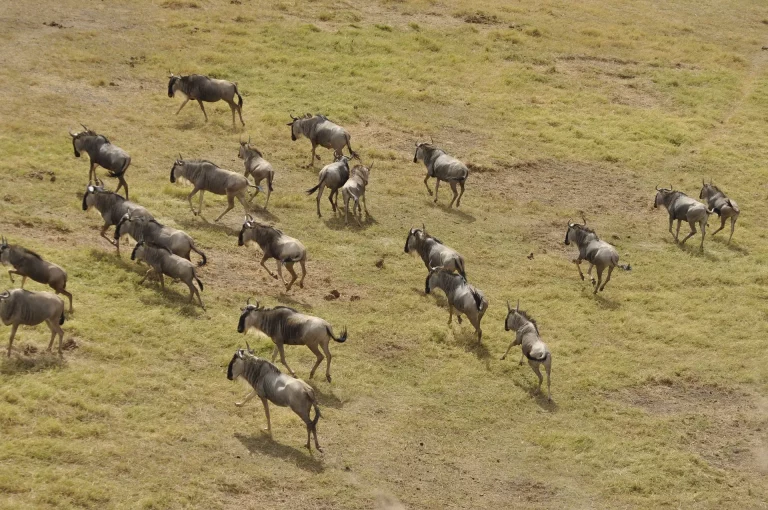
The Classic, 3-Day, 2-Night Masai Mara Safari
From £798
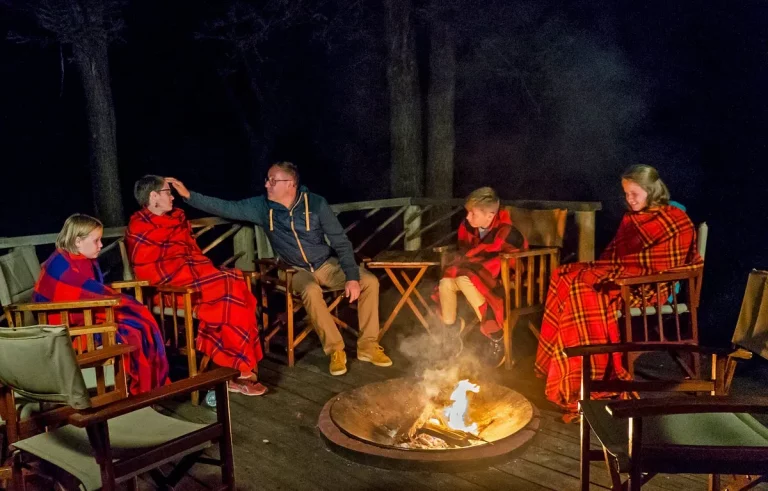
The Luxury, 4-Day, 3-Night Basecamp Masai Mara Safari
From £1233
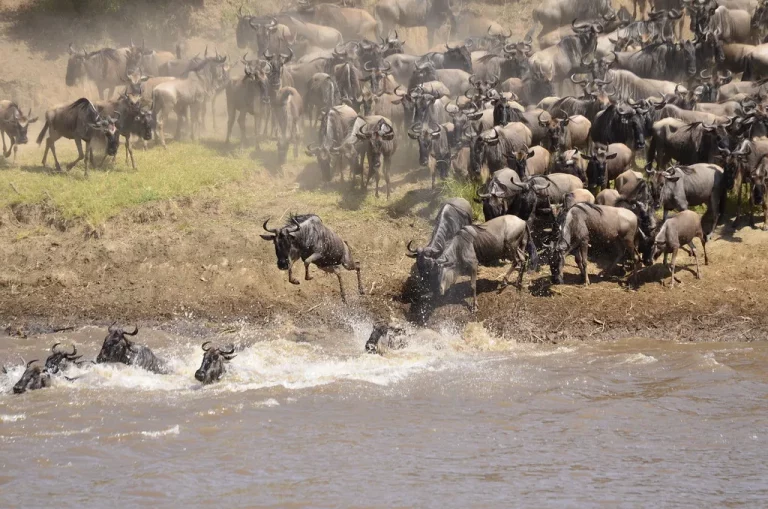
The Super, 5-Day, 4-Night Nairobi & Masai Mara Safari
From £1134
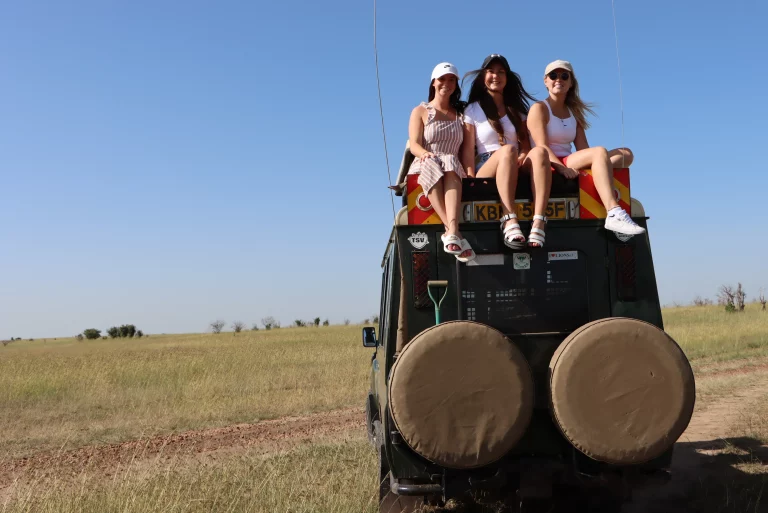
The Memorable, 5-Day, 4-Night Masai Mara Honeymoon Experience
From £1248
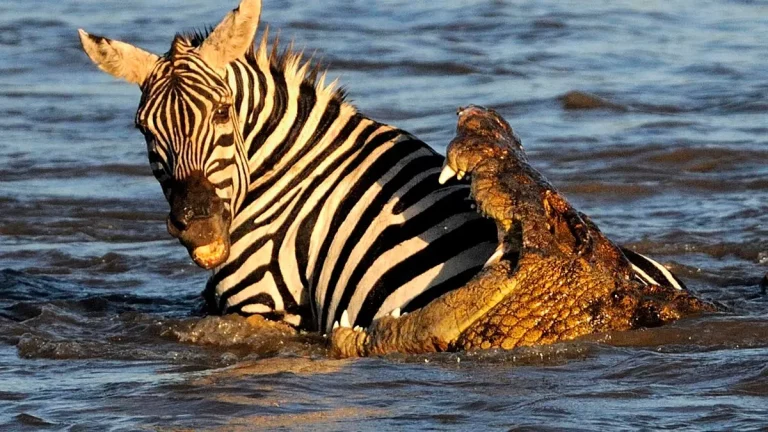
The Budget, 3-Day, 2-Night Jambo Masai Mara Safari
From £887
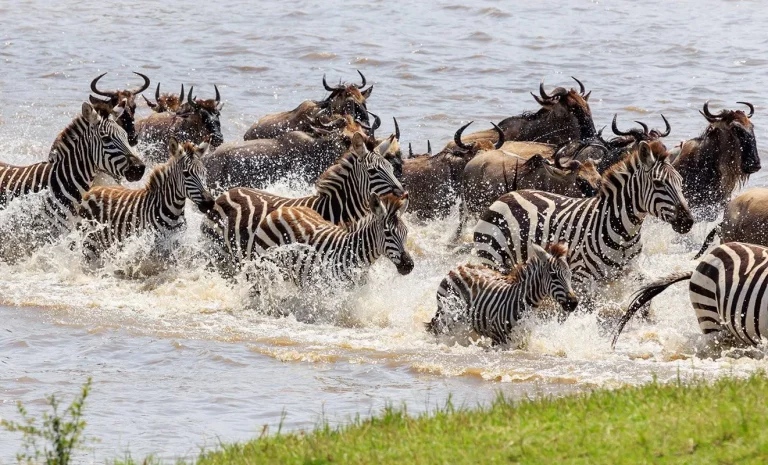
The Perfect, 4-Day, 3-Night Keekorok Lodge Safari
From £1111
Executive Summary
- The Great Wildebeest Migration is a pivotal ecological event that spans over 1,800 miles across the Serengeti-Masai Mara ecosystem, involving over 2 million wildebeest, zebras, and gazelles. It influences the region’s ecology, predator-prey dynamics, and tourism.
- Optimal times to witness the migration include February’s calving season, while peak viewing of perilous river crossings occurs between July and October. Timing a visit requires flexibility due to unpredictable weather patterns influencing the migration.
- Planning a Kenya Wildebeest Migration Safari should include early accommodation booking, consideration of off-peak months for exclusive experiences, and consulting experts for custom-tailored safaris to ensure proximity to key migration events.
Understanding the Great Wildebeest Migration in Kenya
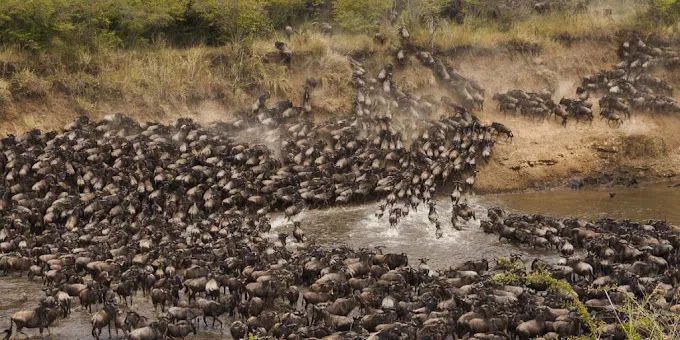
Also known as the Great Migration, the Masai Mara Migration, or the Serengeti Migration, the annual wildebeest migration is a breathtaking display of natural splendor. This cyclical journey covers over 1,800 miles as herds of wildebeest, zebras, and gazelles move between Tanzania’s northern, eastern, and western Serengeti, Central Serengeti, southern Serengeti, and Kenya’s Masai Mara National Reserve in search of greener pastures. As the wildebeest migrate, the impact of this massive movement of animals extends beyond just a fascinating visual spectacle. It plays a critical role in shaping the ecology of the Masai Mara and Serengeti ecosystems and supports a myriad of predator species and local human communities through tourism, making the migration in Masai Mara an essential event for the region.
Why and When does the migration happen?
The herds’ unyielding quest for sustenance propels this remarkable journey, which is influenced by seasonal and weather changes. While the exact timing of the migration is unpredictable, certain key events like calving can be observed during specific periods.
The Circle of Life: Importance of the Migration
The Masai Mara’s circle of life revolves around the Great Migration. As the herds move across the plains, they shape the landscape, affecting nutrient distribution, and grassland maintenance. This influx of herbivores also influences predator-prey interactions. The predators of Masai Mara align their breeding season with the migration, ensuring a constant food supply for their young. During the migration, these carnivores experience a period of abundant food availability, leading to increased survival of their offspring.
The predatory activities intensify around February as the predators target the young and vulnerable wildebeest calves. While this may seem brutal, it is a necessary part of the ecosystem’s balance. The migration aids in controlling the herbivore populations and ensuring the sustainable maintenance of the grasslands within the Masai Mara ecosystem. After all, in nature, everything is interconnected, and the Great Migration is a vivid demonstration of this intricate web of life.
Key Players: Wildebeest, Zebras, and Gazelles
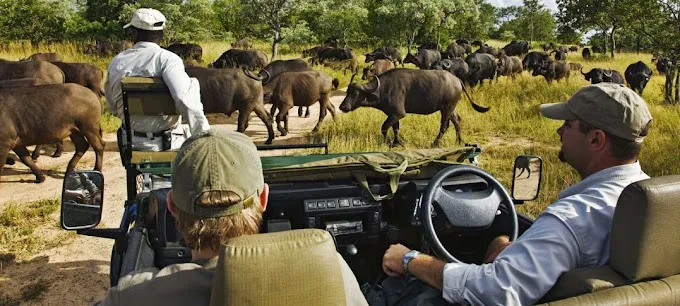
The Great Migration is not embarked upon alone. It’s a grand ensemble of over 1.5 million wildebeest, 400,000 zebras, and 200,000 gazelles. These three species demonstrate a remarkable symbiotic relationship, where each one contributes to the overall success of the journey.
The migration follows a specific pattern:
- Wildebeest, with their ability to graze on coarse, longer grass, lead the way.
- Zebras, which prefer shorter grass, follow behind the wildebeest.
- Gazelles, which can survive on the shortest grass, bring up the rear.
Together, they form a harmonious procession that stretches across the landscape.
Witnessing this procession is like watching a beautifully choreographed ballet on a grand scale. The wildebeest, with their large, box-like bodies and curving horns, are the most numerous. The zebras, with their striking black and white stripes, add a touch of elegance to the scene. The gazelles, with their delicate features and swift movements, bring up the rear, taking advantage of the fresh grazing opportunities created by the preceding herds.
Other animals involved in the Great Migration include;
- Predators such as the wild dog, crocodile, lion, cheetah, leopard, and hyena.
- Crocodile
Timing Your Visit: When to Experience the Kenya Wildebeest Migration
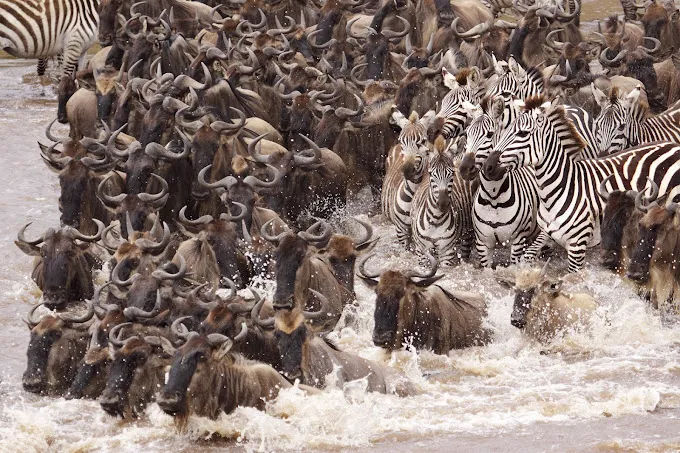
The kind of experience you have during the great migration safari largely depends on when you visit. While the migration is a year-round event, certain peak periods offer the most dramatic wildlife viewing experiences. Here’s a month-by-month breakdown of the great migration route.
January- at this time the herds are in the northeast region of Tanzania’s Serengeti National Park. In mid-January, the herds move south into the area between Ndutu plains and the Ngorongoro Conservation area (home to the Ngorongoro crater, the world’s largest intact caldera).
February to March- The calving season takes center stage at this time. The herds are on the lower northern slopes of the Ngorongoro Crater highlands where they remain till March when they start moving west.
April- April marks the beginning of the rainy season. The animals move north-west towards the Moru and Simba Kopje. Also, the mating season begins at this time.
May- Now that the newborn calves are stronger, the wildebeest funnel their way into Central Serengeti.
June- at this time, the animals are fully settled into Central Serengeti but not for long though. The Grumeti River crossing begins not too long after.
July- The Great Migration finally arrives in the Grumeti Region and some parts of northern Serengeti. The animals who are in constant movement are nearing the Mara River.
August- the wildlife finally arrives at the Mara River where the infamous Mara River crossing happens. Infamous? Yes, infamous! It’s basically a bloodbath as the wildebeest cross the Mara River, bravely fighingt to make it past giant Nile crocodiles.
September- the Mara River crossing is still in full swing
P.S. Not all the animals participate in the crossing- the herds break up into smaller groups, some remain in northern Serengeti while the rest of the herds cross into the Maasai Mara.
October- By late October, the animals that were strong/ lucky enough to win the fight against hungry crocodiles and hippos are now well settled in Kenya’s Masai Mara.
November- November marks the beginning of the short rains. The migrating animals have now exhausted the Maasai Mara grasslands and they must now begin moving back to Tanzania’s Serengeti. By late November the herds are in north-eastern Serengeti where they might split into smaller groups for their return journey southward.
December- the wildebeest herds move south into northern and eastern Serengeti.
Event | Month | Location |
calving season | February to March | Southern Serengeti |
Mating season | April to May | Western Serengeti and Central Serengeti |
Grumeti River crossing | May to June | Central Serengeti |
Mara River Crossing | July to August | Northern Serengeti and Maasai Mara |
On the move | Early November to January | Masai Mara, Northern Serengeti, and Southern Serengeti |
Keep in mind that weather patterns significantly influence the movement of the wildebeest herds, so it’s recommended to be flexible with booking dates.
Peak Season: July to October
The drama of the Great Migration truly comes alive during the peak season from July to late October. This is the time when the herds move from the Serengeti to the Masai Mara, traversing perilous rivers along the way. These river crossings are fraught with dangers such as strong currents and hungry predators, contributing to significant herd losses. The Talek and Mara River crossings are a highlight during this period and can be seen within the Masai Mara.
The combination of massive herds, frequent river crossings, and the threat of predators makes this period the best time for visitors to experience the spectacular wildebeest migration drama. This season promises thrilling wildlife viewing opportunities, with:
- the raw power of survival
- the harsh reality of nature
- the resilience of these creatures
- the circle of life
It’s a sight that will leave you with a profound appreciation for the resilience of these creatures and the circle of life.
P.S. The peak migration season happens during the safari’s high season, so accommodation and flight prices will be higher than usual.
Off-Peak Months: What to Expect
Although the peak season is filled with drama, a safari trip during the off-peak periods of April and May, or after the short rains in November and December, can be just as rewarding. These periods provide a more tranquil safari experience, allowing you to enjoy lush green landscapes and observe a wide array of active wildlife, including predators and their prey, frequently found near abundant water sources.
Off-peak months also provide opportunities for more exclusive safari experiences with fewer tourists, leading to a more intimate connection with nature and comfortable temperatures that avoid the extreme heat of the dry season. The shoulder seasons, such as late January to March or early June, can be strategically used to witness the wildebeest calving or migration movements in less crowded settings, offering a unique opportunity for wildlife enthusiasts.
The Thrilling River Crossings: Where and When to Watch
Think of the Great Wildebeest Migration as a symphony, and the river crossings as its climax. The Mara River crossings occur from late July to August, with additional crossings in September and during the southward return from the last two weeks of October through early November. Meanwhile, the crossings at the Grumeti River typically happen between May and July, marking the initial stage of the river crossing spectacle. These crossings are not just about survival; they are testaments to these animals’ sheer determination and resilience.
To get the best view of these riveting events in the Masai Mara National Reserve, particularly in the Masai Mara’s northern region, several lodges and camps, such as Sayari Camp, Rekero Camp, and Il Moran Camp, are strategically situated near river crossing points. For a distinct perspective of the Masai Mara and river crossings, you can also embark on optional hot-air balloon safaris. Witnessing the Mara River crossings can trigger varied emotional responses, and they are often the most eagerly anticipated element of the migration.
Crocodile Encounters: The Deadly Predators Lurking Below
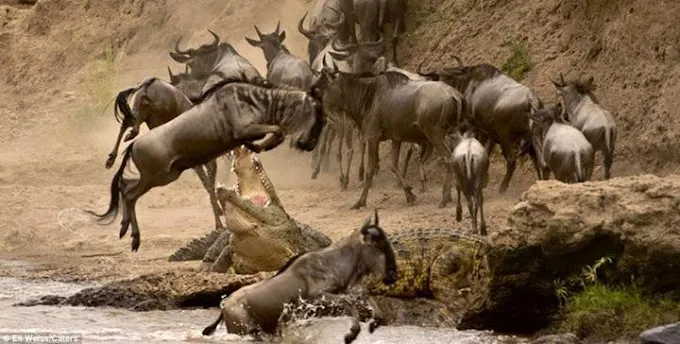
The wildebeest confront substantial dangers during the river crossings, not only from the currents but also from lethal predators concealed beneath the water’s surface. Nile crocodiles, some of Africa’s most fearsome predators, lie in wait, ready to ambush the wildebeest as they cross the perilous crocodile-infested Mara and Talek rivers. These river crossings are not for the faint-hearted. The sight of these massive reptiles launching themselves at the crossing herds is both terrifying and mesmerizing.
Adding to the peril, other predators like lions are particularly active during the river crossings, picking off the stragglers. The presence of these deadly predators during the river crossings adds to the chaos, inciting panic and confusion among the migrating herds. But as harsh as this may appear, it is a necessary part of the cycle of life in the wild, reminding us of the raw and unfiltered reality of nature.
Accommodations and Safari Options for Your Kenya Migration Adventure
Many factors need consideration when planning a migration safari, such as your preferred accommodation and the type of safari experience you desire. During the Great Migration safari, accommodations typically fit into two categories. These are permanent lodges and mobile camps. Your choice between these two options depends on your individual preferences and priorities. Some visitors prefer the comfort and amenities of a permanent lodge, while others seek the authentic and close-to-nature experience of a mobile camp.
For a more intimate and exclusive safari experience, you might consider staying at private conservancies such as Mahali Mzuri and Naboisho Camp, located near the Serengeti National Park. These offer serene settings away from the crowds with added activities like off-road drives and night drives. Family-friendly accommodations such as Singita Faru Faru Lodge and Grumeti Serengeti Tented Camp offer activities for all ages, while couples and honeymooners might prefer the seclusion of smaller camps like Namiri Plains and Mwiba Lodge. Remember, the choice of accommodation during a migration safari can greatly impact the overall experience and budget.
Permanent Lodges vs. Mobile Camps
Providing the comfort of a traditional hotel, permanent lodges come equipped with amenities like spas, fitness centers, and a range of dining options. They provide a perfect blend of luxury and adventure, combining the thrill of a safari with the comforts of a hotel. Staying in a permanent lodge allows you to enjoy the wild without sacrificing the comforts of home.
Conversely, mobile camps deliver a genuine safari experience, complete with luxury amenities like:
- personal butler service
- elegant tent decor
- hot water
- bush dining
- fine wines
- eco-friendly toilets
- family tents
What sets mobile camps apart is their mobility. Luxury mobile camps like andBeyond Serengeti Under Canvas are designed to move with the migrating herds throughout the year, often relocating multiple times to strategic locations based on migration patterns. This ensures that you’re always at the heart of the action, offering an up-close and personal experience of the Great Migration.
Customizable Safari Experiences
Opting for a customizable safari experience could make your adventure truly unforgettable. These are tailored to your individual preferences, group size, and budget, offering unique activities and experiences. Sample itineraries for a customizable safari during the Kenya wildebeest migration offer various lengths of stay, including popular 3-day or 4-day options. You can further enhance your safari with other equally exciting events and activities such as hot air balloon rides or romantic bush dinners.
P.S. Customizable safaris cater to individual travel preferences and group sizes, offering the choice of exclusive-use vehicles for a personalized experience or shared trips for cost-effectiveness. You can choose from a wide range of accommodations, from budget-friendly options to the utmost luxury. Transport options include flying or driving from Nairobi to the Masai Mara, adding convenience and comprehensive care throughout your journey.
Tips for Planning Your Kenya Wildebeest Migration Safari
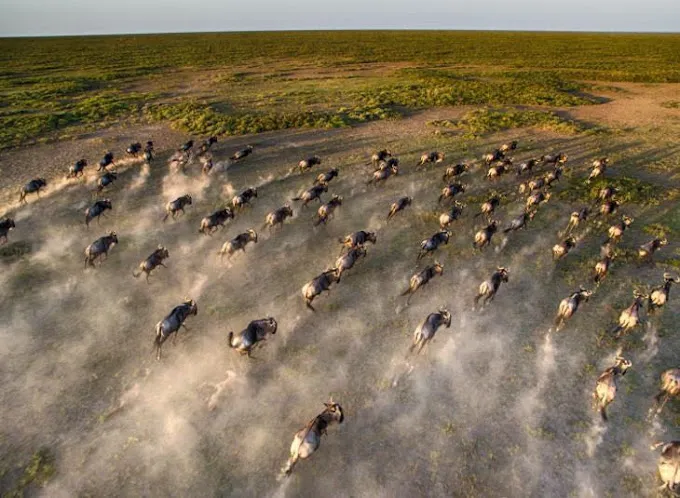
Several key points require consideration when planning your Great Migration Safari: These include;
- Booking your accommodations early, at least a year in advance, to secure lodgings on or very close to the river. This reduces travel time to the viewing areas, ensuring you get the most out of your safari. Remember, the aim is to ensure you’re at the heart of the action for an unforgettable migration encounter.
- Leveraging the knowledge of Africa Safari Experts for custom-tailored safari experiences.
Beyond booking early, enhancing your safari with additional activities such as hot air balloon rides or romantic bush dinners is worth considering. For a more exclusive and personal experience, consider visiting conservancies and private reserves. These areas limit the number of tourists and lodges, helping to avoid crowds. Also, try to combine wildlife viewing with cultural experiences. Visiting a Maasai village, for example, can significantly enhance the safari experience beyond wildlife viewing. It adds a rich cultural component, providing you with a well-rounded adventure that you will remember for years to come.
Timing is Everything: Scheduling Your Trip Wisely
Although the Great Wildebeest Migration is a year-round event, bear in mind that factors like climate change and irregular rainy seasons can render the timing of events unpredictable. Therefore, planning for as much time on safari as possible is crucial to account for this unpredictability. Try to allow for flexibility in your schedule to ensure you don’t miss the key events of the migration.
Consulting historical data of previous migrations can provide a more accurate prediction of migration movements, aiding in trip scheduling. This can help you plan your trip at the right time to witness the most dramatic moments of the migration. Remember, timing is everything when it comes to experiencing the Great Wildebeest Migration in all its glory.
Enhancing Your Experience: Combining Destinations
For a more immersive safari experience, you might want to consider incorporating a variety of destinations and activities. This not only allows you to witness diverse wildlife but also provides a broader perspective on East Africa’s rich natural and cultural heritage. For instance, visiting a Maasai village can significantly enhance the safari experience beyond wildlife viewing. You can engage with the Maasai people, learn about their traditions, and participate in cultural activities like singing and dancing. This adds a rich cultural component to your safari and provides a deeper understanding of the local way of life.
Some luxury mobile camps offer a more comprehensive safari experience including walking safaris, night drives, in addition to cultural experiences. This combination of wildlife, unique activities, and cultural immersion provides a multidimensional experience of East Africa’s rich natural and cultural heritage. Whether you are a wildlife enthusiast or a culture buff, these experiences will surely enrich your overall safari adventure.
Summary
Whether it’s the thundering hooves of millions of wildebeest, the tense drama at the river crossings, or the breathtaking landscapes of the Serengeti and Masai Mara, the Great Wildebeest Migration is a spectacle like no other. This extraordinary natural event, coupled with a safari adventure tailored to your preferences, offers an unforgettable experience. So, whether you choose a permanent lodge or a mobile camp, a peak season visit or an off-peak adventure, remember to book early, plan wisely, and immerse yourself not just in the wildlife but also in the rich cultural experiences. After all, the Great Wildebeest Migration is not just a journey; it’s a testament to the indomitable spirit of life itself.
Frequently Asked Questions
What month is the Great Migration in Kenya?
The Great Migration in Kenya occurs from July to October when 1.5 million wildebeests enter the Masai Mara.
What is the Great Migration?
Hailed as the planet’s largest animal migration, the Great Migration is a spectacular spectacle that sees over two million animals move in a clockwise direction to and from the Serengeti Mara ecosystem. The migrating animals follow an age-old route where they cross crocodile-infested waters and brave natural disasters such as drought and floods.
Why do the Wildebeest Migrate?
It is generally believed that the Great Migration is dictated primarily by the rains (weather). The animals moving migrate to the region where new grass has grown after the rains.
What months are the wildebeest migration?
The wildebeest migration occurs from July to October, making it the best time to visit the Masai Mara for optimal game viewing with plenty of predator and prey interactions.
What is the Masai Mara migration 2024?
The Masai Mara migration in 2024 involves a massive annual movement of over two million wildebeest, along with hundreds of thousands of zebras and various other herbivores.
What is the significance of the Great Wildebeest Migration?
The Great Wildebeest Migration is significant for the Masai Mara ecosystem as it influences predator-prey interactions, herbivore population control, and grassland maintenance. It plays a crucial role in maintaining the ecosystem’s balance.
What dangers do the wildebeest face during the migration?
During the migration, wildebeest face significant dangers such as strong river currents and predatory threats like Nile crocodiles.
